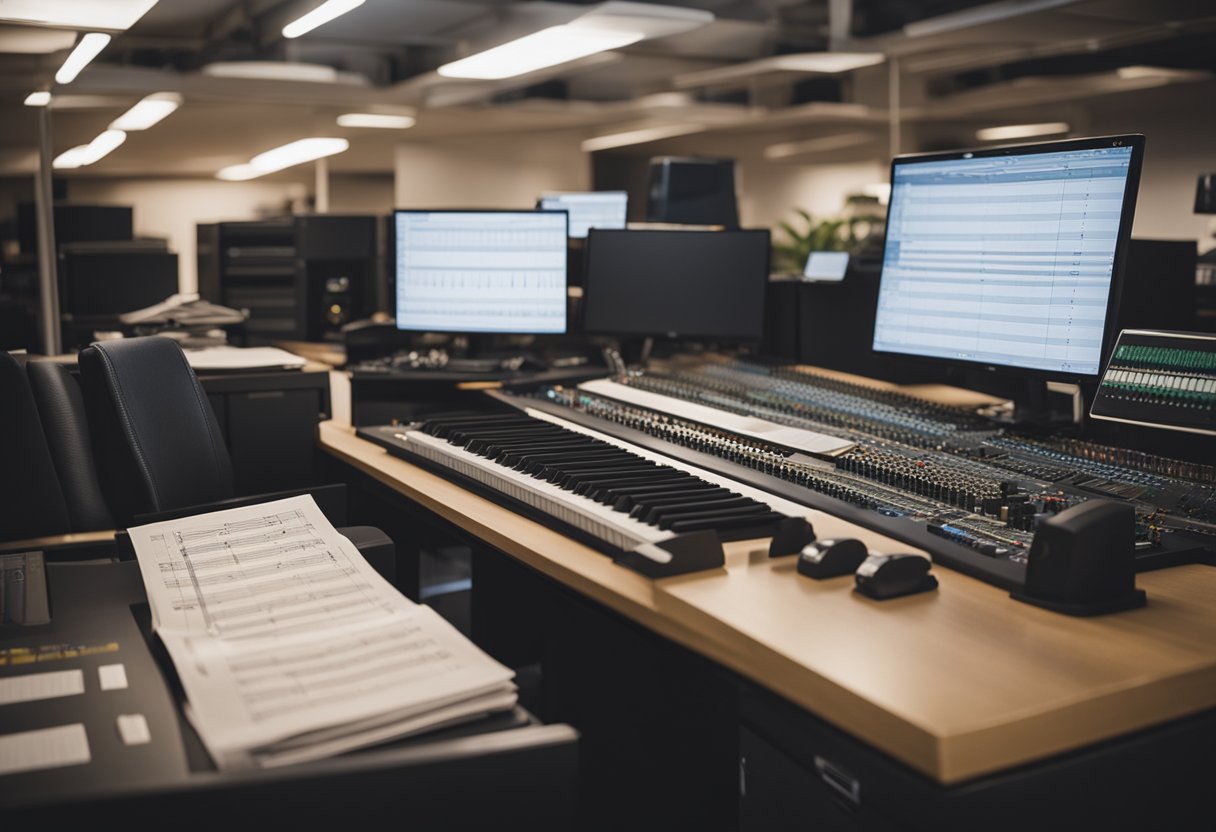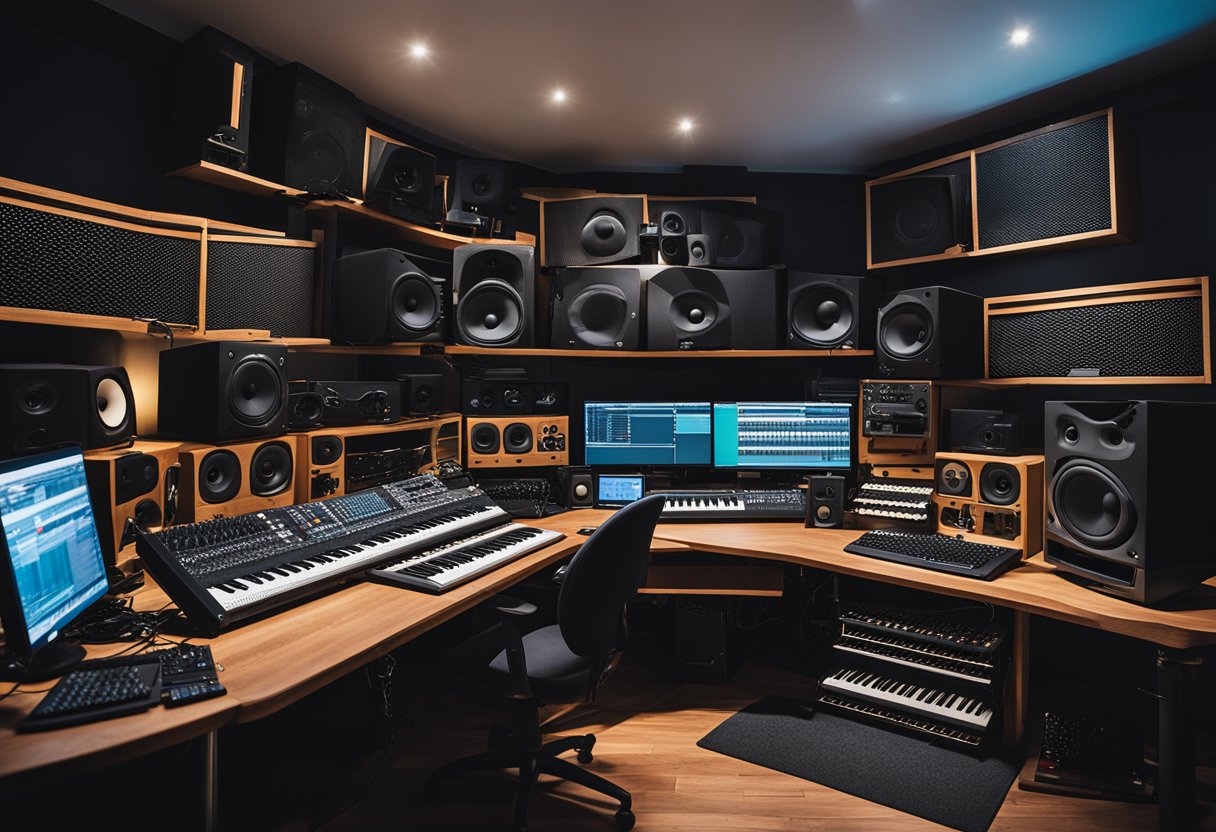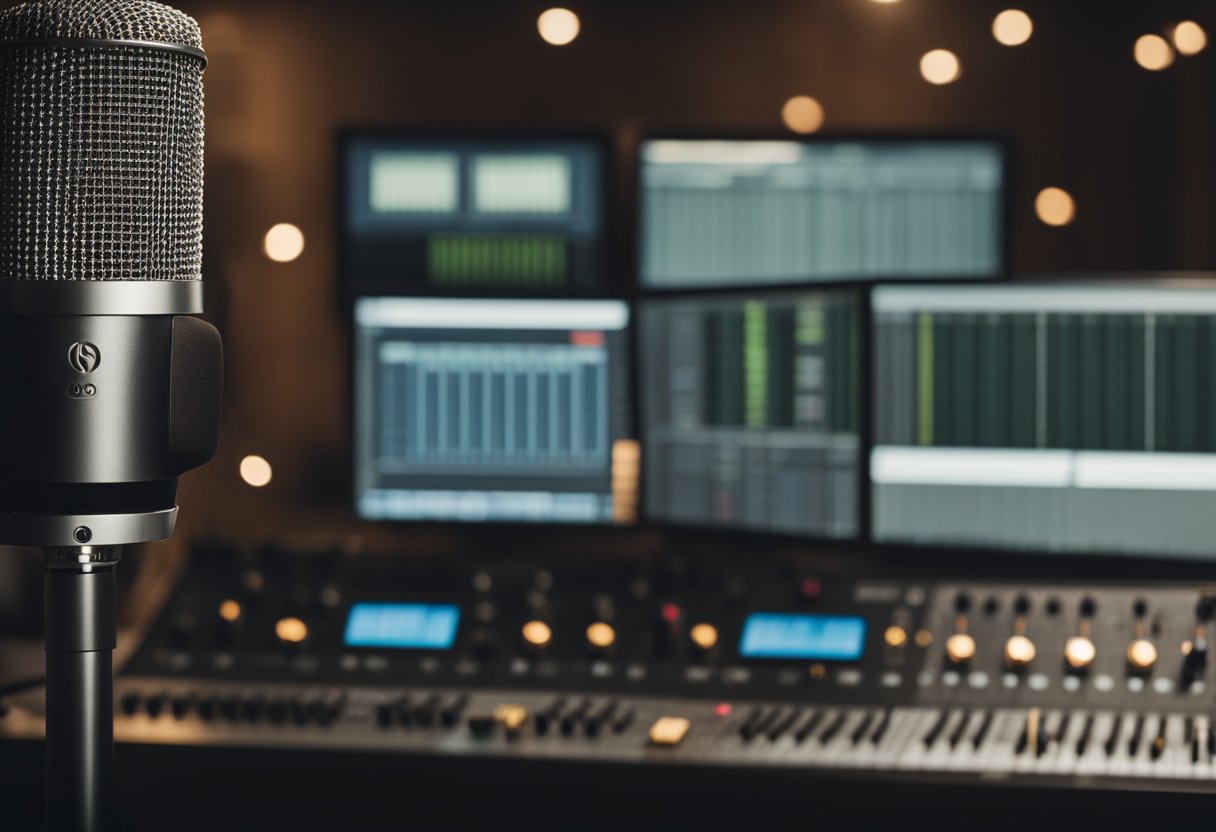Music licensing and royalties are crucial components of the music industry that help artists get paid for their work. Music licensing refers to the process of obtaining permission to use copyrighted music, while royalties are the payments made to the copyright holder for the use of their music. These payments are essential for the survival of artists and the music industry as a whole.

The basics of music licensing involve obtaining permission from the copyright holder to use their music for a specific purpose, such as in a film, TV show, or commercial. This process can be complicated and involves negotiating fees and terms of use. Royalty streams in music are the various ways in which artists can earn money from their music, including through streaming services, radio play, and live performances. Understanding these streams is crucial for artists to maximize their earnings and ensure they are being paid fairly.
Key Takeaways
- Music licensing and royalties are vital for artists to get paid for their work.
- The licensing process involves obtaining permission to use copyrighted music, negotiating fees and terms of use.
- Royalty streams in music include streaming services, radio play, and live performances, which are essential for artists to maximize their earnings.
Basics of Music Licensing
Music licensing is the process of obtaining permission to use copyrighted music in various forms of media, such as films, TV shows, commercials, and video games. This process involves paying royalties to the copyright owner for the right to use their music.
Types of Music Licenses
There are different types of music licenses available, and each has its own set of terms and conditions. The most common types of music licenses are:
- Mechanical License: This type of license is required to reproduce and distribute a copyrighted musical composition, such as in a CD or digital download. The royalty rate for a mechanical license is typically a percentage of the wholesale price of the product.
- Synchronization License: This type of license is required to use a musical composition in a visual production, such as a film or TV show. The royalty rate for a synchronization license is negotiated between the copyright owner and the licensee.
- Performance License: This type of license is required to publicly perform a copyrighted musical composition, such as in a concert or on the radio. The royalty rate for a performance license is typically based on the size of the audience and the frequency of performances.
Understanding Copyright in Music
Copyright is a legal concept that gives the creator of a work the exclusive right to use and distribute that work. In the case of music, copyright protects the musical composition (the melody and lyrics) as well as the sound recording (the actual performance of the song).
In order to obtain a music license, it is important to determine who owns the copyright to the song. This can be the songwriter, the publisher, or a record label.
Role of Performing Rights Organizations
Performing Rights Organizations (PROs) are companies that represent songwriters and publishers and collect royalties on their behalf. In the United States, there are three main PROs: ASCAP, BMI, and SESAC.
PROs collect royalties for the public performance of musical compositions, such as in a concert or on the radio. They also issue licenses to businesses that want to publicly perform music, such as restaurants and bars.
In conclusion, understanding the basics of music licensing is essential for anyone looking to use copyrighted music in their creative projects. By obtaining the proper licenses and paying royalties to the copyright owner, individuals and businesses can avoid legal issues and ensure that artists are compensated for their work.
Royalty Streams in Music
Music licensing and royalties are an essential part of the music industry. Royalties are payments made to artists, songwriters, and publishers for the use of their music. There are different types of royalties in the music industry, including mechanical royalties, performance royalties, synchronization royalties, and print music royalties.
Mechanical Royalties
Mechanical royalties are paid to songwriters and publishers for the reproduction and distribution of their music. These royalties are paid to the copyright owner of the song for the use of their music in physical or digital formats. Mechanical royalties are paid by record labels, streaming services, and other music distributors.
Performance Royalties
Performance royalties are paid to songwriters, publishers, and performers for the public performance of their music. These royalties are paid when music is played on the radio, TV, in public places, or live performances. Performance royalties are collected by performing rights organizations (PROs) such as ASCAP, BMI, and SESAC in the United States.
Synchronization Royalties
Synchronization royalties are paid to songwriters and publishers for the use of their music in TV shows, movies, commercials, and video games. These royalties are paid for the synchronization of music with visual media. Synchronization royalties are negotiated between the music publisher and the producer of the visual media.
Print Music Royalties
Print music royalties are paid to songwriters and publishers for the use of their music in printed sheet music, songbooks, and other printed music materials. These royalties are paid for the reproduction and distribution of printed music. Print music royalties are paid by music publishers and distributors.
In conclusion, royalties are essential for the music industry, and they help compensate artists, songwriters, and publishers for the use of their music. Understanding the different types of royalties can help music creators and copyright owners receive fair compensation for their work.
The Licensing Process
Music licensing is a crucial part of the music industry that ensures that artists and creators are compensated for their work. The licensing process involves negotiating license agreements, clearance procedures for music use, and licensing for different media platforms.
Negotiating License Agreements
The licensing process begins with negotiating license agreements between the music owner and the licensee. License agreements outline the terms of use, payment, and other important details. Negotiating license agreements requires careful attention to detail and a thorough understanding of the legal and financial aspects of the music industry.
Clearance Procedures for Music Use
Clearance procedures for music use are an essential part of the licensing process. Clearance procedures ensure that the licensee has the legal right to use the music in question. This involves obtaining permission from the music owner, verifying ownership, and ensuring that all necessary licenses and permissions are in place.
Licensing for Different Media Platforms
Licensing for different media platforms is another important aspect of the licensing process. Different media platforms have different licensing requirements, and it is important to understand these requirements in order to ensure that the music is used legally and that the appropriate royalties are paid.
Overall, the licensing process is a complex and important part of the music industry. By following the proper procedures and obtaining the necessary licenses and permissions, music creators can ensure that their work is protected and that they receive the compensation they deserve.
Music Publishing and Distribution

Music Publishing Overview
Music publishing involves the administration of music copyrights and the collection of royalties. Publishers are responsible for promoting and protecting the rights of songwriters and composers. They also work to secure licensing deals for their catalog of songs and collect royalties from those deals.
Publishers typically take a percentage of the revenue generated by a song, which can range from 10% to 50%. In exchange, they provide services such as copyright registration, song pitching, and royalty collection. Songwriters and composers often sign exclusive or non-exclusive agreements with publishers to manage their catalog of songs.
Distribution Channels and Revenue
Once a song is published, it can be distributed through various channels, including physical and digital sales, streaming services, and synchronization licenses for use in film, TV, and commercials. Each distribution channel generates revenue for the publisher and songwriter in different ways.
Physical sales include CDs, vinyl, and other physical formats. Revenue is generated through the sale of these formats, and royalties are paid to the publisher and songwriter based on the sales.
Digital sales include downloads from online retailers such as iTunes and Amazon. Revenue is generated through the sale of digital downloads, and royalties are paid to the publisher and songwriter based on the sale.
Streaming services such as Spotify and Apple Music generate revenue through monthly subscription fees and advertising. Royalties are paid to the publisher and songwriter based on the number of streams a song receives.
Synchronization licenses are agreements that allow a song to be used in film, TV, and commercials. Revenue is generated through licensing fees, and royalties are paid to the publisher and songwriter based on the usage.
In conclusion, music publishing and distribution are essential components of the music industry. Publishers work to protect the rights of songwriters and composers and collect royalties from various distribution channels. Understanding the different revenue streams and how they generate income is crucial for anyone looking to make a career in music.
Legal Considerations
Copyright Law and Infringement
Copyright law protects the rights of creators of original works of authorship, including music. Music licensing allows individuals or entities to use copyrighted music in their projects or performances. Licensing music requires obtaining permission from the owner of the copyright, who is usually the songwriter or music publisher. Failure to obtain a license can result in legal action for copyright infringement.
Fair Use Doctrine
Fair use is a legal doctrine that allows for the limited use of copyrighted material without permission from the copyright owner. Fair use applies to situations such as criticism, commentary, news reporting, teaching, scholarship, and research. However, determining whether a particular use of copyrighted material qualifies as fair use can be complex and requires consideration of several factors, including the purpose and character of the use, the nature of the copyrighted work, the amount and substantiality of the portion used, and the effect of the use on the potential market for the copyrighted work.
Legal Disputes and Resolution
Legal disputes can arise in music licensing and royalties when there are disagreements over the terms of a license or the amount of royalties owed. Disputes may also arise when there are allegations of copyright infringement or breach of contract. In such cases, resolution may involve negotiation, mediation, or litigation. It is important to have a clear understanding of the terms of any license agreement and to seek legal advice if a dispute arises.
Global Music Markets
International Licensing
Music licensing has become a global phenomenon, with artists and record labels licensing their music to various countries around the world. International licensing allows music to reach a wider audience and generate more revenue for the artists and record labels. It also helps in promoting cultural exchange and diversity.
The licensing process involves negotiating and signing agreements with local music publishing companies, who then distribute the music to various platforms such as radio stations, streaming services, and TV networks. The agreements also cover the use of music in advertising, movies, and other media.
Cross-Border Royalty Collection
Royalty collection is an essential aspect of music licensing, as it ensures that artists and record labels are compensated for the use of their music. Cross-border royalty collection, however, can be challenging due to the differences in copyright laws and royalty collection systems across various countries.
To address this, various organizations such as the International Confederation of Societies of Authors and Composers (CISAC) and the International Music Managers Forum (IMMF) have been established to facilitate cross-border royalty collection and ensure that artists and record labels are paid their fair share.
In conclusion, global music markets have created opportunities for artists and record labels to reach a wider audience and generate more revenue. However, the licensing and royalty collection process can be complex, and it is essential to work with experienced professionals to navigate through the legal and financial aspects of the music industry.
Emerging Trends in Music Licensing

Digital Streaming and Monetization
With the rise of digital streaming services such as Spotify, Apple Music, and Tidal, the music industry has seen a significant shift in the way music is consumed and monetized. These services have made it easier for users to access music from anywhere and at any time, leading to a rise in the number of subscribers and revenue generated from streaming.
Music licensing has also evolved to keep up with these changes. Streaming services now pay royalties to artists and songwriters based on the number of streams their music receives. This has led to a more equitable distribution of revenue among musicians and has made it easier for independent artists to monetize their music.
Innovations in Music Technology
Advancements in music technology have also had a significant impact on music licensing and royalties. For example, artificial intelligence (AI) and machine learning algorithms are now being used to analyze music and identify potential copyright infringement. This has made it easier for music licensing companies to monitor and enforce copyright laws.
In addition, blockchain technology is being explored as a way to improve transparency and accountability in the music industry. By creating a decentralized database of music rights ownership, blockchain could help ensure that artists and songwriters receive fair compensation for their work.
Overall, these emerging trends in music licensing and royalties are helping to create a more sustainable and equitable music industry. As technology continues to evolve, it will be interesting to see how it shapes the future of music licensing and royalties.
Frequently Asked Questions
How are music royalties calculated and distributed?
Music royalties are calculated based on the usage of the music and the terms of the licensing agreement. The amount of royalties can vary depending on factors such as the type of use (e.g. streaming, broadcast, live performance), the territory in which the music is used, and the specific terms of the agreement. Royalties are typically split between the songwriter and the publisher, with each receiving a percentage of the total amount.
What are the differences between mechanical and performance royalties?
Mechanical royalties are paid to songwriters and publishers for the reproduction of their music on physical or digital media, such as CDs, downloads, and streams. Performance royalties, on the other hand, are paid for the public performance of the music, such as on radio, TV, and live performances. Performance royalties are collected by performance rights organizations (PROs) and distributed to the songwriter and publisher.
Who is eligible to receive song royalties once a track is licensed?
The songwriter and publisher are typically the parties eligible to receive song royalties once a track is licensed. If the songwriter has assigned their rights to a music publisher, the publisher will receive a portion of the royalties. In some cases, the artist who performs the song may also be entitled to a portion of the royalties.
What is the process for obtaining a music license for commercial use?
The process for obtaining a music license for commercial use can vary depending on the specific use and the rights holder. In general, the licensee will need to contact the rights holder and negotiate the terms of the license, including the duration of the license, the territory in which the music can be used, and the amount of royalties to be paid.
How does radio play impact royalty payments for artists?
Radio play can have a significant impact on royalty payments for artists. In most cases, radio stations are required to pay performance royalties to PROs for the use of music on their broadcasts. These royalties are then distributed to the songwriter and publisher. The amount of royalties paid can vary depending on factors such as the number of plays, the length of the song, and the size of the audience.
What role do music rights organizations play in the collection of royalties?
Music rights organizations, such as ASCAP, BMI, and SESAC, play a crucial role in the collection of royalties for songwriters and publishers. These organizations collect performance royalties from various sources, including radio stations, TV networks, and live performance venues. The royalties are then distributed to the rights holders based on the usage of their music.



